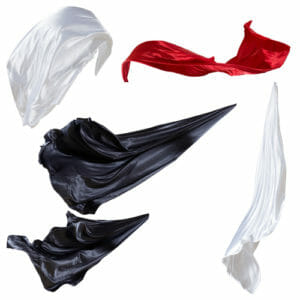
Silk satin – the very name conjures up images of opulence, sophistication, and timeless elegance. This luxurious fabric, with its unmistakable sheen and soft-to-the-touch feel, has been a favorite of royalty and fashion houses for centuries. But did you know that it’s not just for the elite?
If you're thinking about creating a wedding gown or any garment for a super special occasion, chances are you are thinking about using silk satin for this very important project. One the most expensive types of cloth, silk satin is the perfect choice when you want to create something very grand and luxurious like the beautiful dress below.


Today, more and more home sewists are discovering the joys of working with silk satin, and it's not hard to see why. Beyond its visual appeal, this fabric offers a unique sewing experience that can elevate any project to new heights. Whether you’re looking to craft a statement evening gown, design a lavish pillowcase, or even add a touch of luxury to everyday items, silk satin can be your go-to fabric.
Origins of Silk Satin
First woven by the silk weavers of Quanzhou, China, the shimmery satin fabric is actually woven and is considered a fabric blend. The original satin was made exclusively from silk thread, making it quite expensive, and it soon gained popularity among the royal families and the wealthy during the 12th Century. For several decades, the kings and queens of Europe and the emperors and empresses of China draped themselves with royal robes made from silk satin.


And then some weavers started to manufacture satin fabrics using other materials like polyester, wool, and cotton. This makes satin less expensive so that today when we say satin, we normally refer to a type of weaving that enhances the facade of the fabric by providing it with a glossy finish. And the good news is that normal mortals like you and me can now afford satin. In fact, it has become the fabric of choice for bed sheets, upholstery, and gowns for any special occasion. Satin is also popularly used as the material for athletic shorts and jackets, ladies’ lingerie, nightgowns, swimwear, boxer shorts, men’s shirts and neckties. The ballet pointe shoes are also made of satin.
If you'd like to dive deeper into the history of silk, check out our two part series on the history of silk here.
Satin Weaving
The process used in producing satin fabric is called twill weaving. This is a type of weaving that utilizes weft threads with four or more horizontal yarns covered by a single vertical yarn. The result is satin’s unique smoothness that is largely due to the weave’s fewer interlacings. There are still many innovations being developed in the manufacture of the satin fabric blend and this is really good news for all of us. Imagine working on stretch satin fabrics or being able to create something out of satin fabrics decorated with the latest trendy digital prints.


Sewing with Satin
Are you getting ready to work with satin? You probably know that it is a bit difficult to work with this special material because it keeps on slipping away. So make sure you pin its edges on tissue paper by using special satin pins. You should also take extra care that it does not get creases because it will be difficult to remove these creases later on. Finally, it is important to use only sharp and good quality scissors when you work with satin. For guidance on choosing high-quality sewing scissors, please check our Tool tips – budget or quality? Sewing scissors.
And as you sew, you will surely agree that this is a material that is truly fit for kings –or anyone that you hold especially dear for that matter. You see, no other fabric has this soothing feeling on the skin. Satin made from natural materials lets the skin breathe by letting air pass through and this creates a cooling effect too.
A Sewist's Guide to Working with Silk Satin
Silk satin's delicate nature can pose challenges to even seasoned sewists. With the right techniques and a bit of patience, though, you can master the art of sewing with silk satin. Here's a step-by-step guide to help you navigate the process:
Preparation
- Pre-wash: Some silk satins can shrink, so consider pre-washing your fabric. Do this gently by hand with cold water and a mild detergent. Avoid wringing the fabric; instead, press out excess water between towels and lay it flat to dry.
- Ironing: Use a low setting on your iron and always press on the wrong side of the fabric, preferably with a pressing cloth in between to prevent shine or scorch marks.
Cutting
- Stabilizing: To prevent the fabric from slipping, lay it on a sheet or tissue paper while cutting.
- Layout: Ensure you're cutting in a single layer. This prevents the fabric from shifting and ensures a more accurate cut.
- Pinning: Use fine, sharp pins to avoid snagging the fabric. Pin within the seam allowances to prevent visible pin holes.
Sewing
- Needle & Thread: Use a fine, sharp needle (like a size 60/8 or 70/10) and 100% silk or cotton thread.
- Stitches: Opt for a shorter stitch length (around 2.0-2.5) for better seam integrity.
- Seam Finishes: As silk satin frays easily, consider using French seams, serged edges, or bound seams for a neat finish.
- Feed: A walking foot or a Teflon foot can help feed the fabric evenly and prevent it from slipping.
Pressing
- Use a Pressing Cloth: This will protect the fabric from the direct heat of the iron and prevent shine.
- Seam Rolls: Use seam rolls to press seams open, ensuring they're crisp without pressing marks on the right side of the fabric.
Finishing Touches
- Hemming: A rolled hem, either by hand or with a rolled hem foot, works best for silk satin.
- Interfacing: If you need to interface parts of your garment, choose a lightweight, fusible interfacing suitable for delicate fabrics.
Care & Maintenance
- Washing: Always hand wash or dry clean silk satin garments to maintain their sheen and texture.
- Storage: Store silk satin garments in a cool, dry place, away from direct sunlight.
Tips & Tricks
- Test First: Before sewing or applying any interfacing, always test on a scrap piece of your silk satin.
- Stay Calm: Silk satin can be slippery and challenging, but take your time and remember that patience is key!
Classy and comfortable, it is no wonder that after all these years, silk satin is still considered as one of the best things that ever happen to the history of fabric and fabric blends. What delicious creations would you like to make with silk satin? Please let us know in the comments below.








I want to trim the sleeves of a flannel dress for my great-granddaughter in a contrasting color and hand.
interesting!
made my daughter’s wedding dress from silk satin, but now i know all about the material too.
thanks
I line all my creations of Muskogee Creek Indian vest with silk. Can I fuse a light fusable pellon to silk to ease the delicate handling of the silk liner?
I would love to make luxurious night gowns, bras and panties. No telling what I might make.
I have a small amount of black satin and blue satin. i was wondering if you had any ideas of what to sew with them? I’m a beginner sewer who wants to make something nice for my grandma who bought me the sewing machine and the blue satin.
How much Satin you have of both? Tell me…and I will be able to give you a few ideas.
I decided I want to make myself a dress in red satin long sleeves, pockets, full skirt and below the knee., very 50’s
Sounds like a good plan and a lovely dress.
Thank you for educating me on “sew” many topics! I would love to make a lovely satin camisole or two or three. LOL